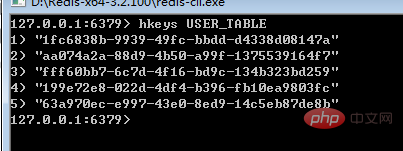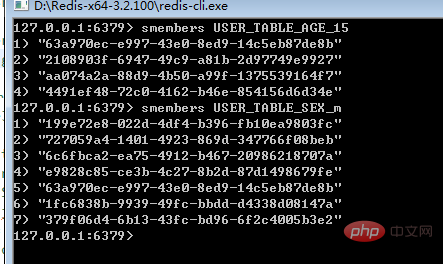redis implements simple conditional query

1. Import the jar package

2. Implement a simple conditional query
Create a User entity class
public class User {
private String id;
private String name;
private String sex;
private int age;
public String getId() {
return id;
}
public User() {
super();
}
public void setId(String id) {
this.id = id;
}
public String getName() {
return name;
}
public void setName(String name) {
this.name = name;
}
public String getSex() {
return sex;
}
public void setSex(String sex) {
this.sex = sex;
}
public int getAge() {
return age;
}
public void setAge(int age) {
this.age = age;
}
public User(String id, String name, String sex, int age) {
super();
this.id = id;
this.name = name;
this.sex = sex;
this.age = age;
}
@Override
public String toString() {
return "User [id=" + id + ", name=" + name + ", sex=" + sex + ", age="
+ age + "]";
}
}Create 5 objects and store them in the cache for us to test
//连接redis
Jedis jedis = new Jedis("127.0.0.1",6379);
Map<String, String> map = new HashMap<String,String>();
final String USER_TABLE = "USER_TABLE";
//向缓存中存入5条数据组成的map
String uuid1 = UUID.randomUUID().toString();
User user1 = new User(uuid1, "y1", "m", 15);
//将对象转为json
map.put(uuid1, JSONObject.fromObject(user1).toString());
String uuid2 = UUID.randomUUID().toString();
User user2 = new User(uuid2, "y2", "m", 18);
map.put(uuid2, JSONObject.fromObject(user2).toString());
String uuid3 = UUID.randomUUID().toString();
User user3 = new User(uuid3, "y3", "n", 25);
map.put(uuid3, JSONObject.fromObject(user3).toString());
String uuid4 = UUID.randomUUID().toString();
User user4 = new User(uuid4, "y4", "n", 15);
map.put(uuid4, JSONObject.fromObject(user4).toString());
String uuid5 = UUID.randomUUID().toString();
User user5 = new User(uuid5, "y5", "m", 25);
map.put(uuid5, JSONObject.fromObject(user5).toString());
//把map存到缓存中
jedis.hmset("USER_TABLE", map);Query in redis, you can see that 5 user objects have been stored in the cache

Next, first implement a single-condition query, for example, query a user with an age of 15 and a user with a gender of m
Since Redis is nosql, it cannot be directly Like mysql, where is used to perform conditional queries, so if Redis wants to implement conditional queries, it can only use a stupid method: save all users who meet the conditions into a set.
Jedis jedis = new Jedis("127.0.0.1",6379);
Map<String, String> map = new HashMap<String,String>();
final String USER_TABLE = "USER_TABLE";
//查询年龄为15,性别为n
final String USER_TABLE_AGE_15 = "USER_TABLE_AGE_15";
final String USER_TABLE_SEX_m = "USER_TABLE_SEX_m";
final String USER_TABLE_SEX_n = "USER_TABLE_SEX_n";
//向缓存中存入5条数据组成的map
String uuid1 = UUID.randomUUID().toString();
User user1 = new User(uuid1, "y1", "m", 15);
//将对象转为json
map.put(uuid1, JSONObject.fromObject(user1).toString());
//将符合条件的user的Id存到set中
jedis.sadd(USER_TABLE_AGE_15,uuid1);
jedis.sadd(USER_TABLE_SEX_m,uuid1);
String uuid2 = UUID.randomUUID().toString();
User user2 = new User(uuid2, "y2", "m", 18);
map.put(uuid2, JSONObject.fromObject(user2).toString());
jedis.sadd(USER_TABLE_SEX_m,uuid2);
String uuid3 = UUID.randomUUID().toString();
User user3 = new User(uuid3, "y3", "n", 25);
map.put(uuid3, JSONObject.fromObject(user3).toString());
String uuid4 = UUID.randomUUID().toString();
User user4 = new User(uuid4, "y4", "n", 15);
map.put(uuid4, JSONObject.fromObject(user4).toString());
jedis.sadd(USER_TABLE_AGE_15,uuid4);
String uuid5 = UUID.randomUUID().toString();
User user5 = new User(uuid5, "y5", "m", 25);
map.put(uuid5, JSONObject.fromObject(user5).toString());
jedis.sadd(USER_TABLE_SEX_m,uuid5);
//把map存到缓存中
jedis.hmset("USER_TABLE", map);
So, if you want to query the user whose age is 15, you need to first remove all uuid from USER_TABLE_AGE_15, and then remove the user from USER_TABLE
//获取年龄为15的user的uuid
Set<String> age = jedis.smembers(USER_TABLE_AGE_15);
//根据uuid获取user
List<User> userJson = new ArrayList<User>();
for (Iterator iterator = age.iterator(); iterator.hasNext();) {
String string = (String) iterator.next();
String jsonStr = jedis.hget(USER_TABLE, string);
JSONObject json = JSONObject.fromObject(jsonStr);
User user = (User) JSONObject.toBean(json, User.class);
userJson.add(user);
System.out.println(user);
}The results are as follows:
User [id=63a970ec-e997-43e0-8ed9-14c5eb87de8b, name=y1, sex=m, age=15] User [id=aa074a2a-88d9-4b50-a99f-1375539164f7, name=y4, sex=n, age=15]
So if you need a user with age 15 and gender m, it is very simple. Get the union of
USER_TABLE_AGE_15 and USER_TABLE_SEX_m, and then get it from USER_TABLE.
//获取年龄为15并性别为m的user
Set<String> userSet = jedis.sinter(USER_TABLE_AGE_15,USER_TABLE_SEX_m);
List<User> users = new ArrayList<User>();
for (Iterator iterator = userSet.iterator(); iterator.hasNext();) {
String string = (String) iterator.next();
String jsonStr = jedis.hget(USER_TABLE, string);
JSONObject json = JSONObject.fromObject(jsonStr);
User user = (User) JSONObject.toBean(json, User.class);
users.add(user);
System.out.println(user);
}User [id=63a970ec-e997-43e0-8ed9-14c5eb87de8b, name=y1, sex=m, age=15]
For more redis knowledge, please pay attention to the redis introductory tutorial column.
The above is the detailed content of redis implements simple conditional query. For more information, please follow other related articles on the PHP Chinese website!

Hot AI Tools

Undresser.AI Undress
AI-powered app for creating realistic nude photos

AI Clothes Remover
Online AI tool for removing clothes from photos.

Undress AI Tool
Undress images for free

Clothoff.io
AI clothes remover

Video Face Swap
Swap faces in any video effortlessly with our completely free AI face swap tool!

Hot Article

Hot Tools

Notepad++7.3.1
Easy-to-use and free code editor

SublimeText3 Chinese version
Chinese version, very easy to use

Zend Studio 13.0.1
Powerful PHP integrated development environment

Dreamweaver CS6
Visual web development tools

SublimeText3 Mac version
God-level code editing software (SublimeText3)

Hot Topics
 1387
1387
 52
52
 How to build the redis cluster mode
Apr 10, 2025 pm 10:15 PM
How to build the redis cluster mode
Apr 10, 2025 pm 10:15 PM
Redis cluster mode deploys Redis instances to multiple servers through sharding, improving scalability and availability. The construction steps are as follows: Create odd Redis instances with different ports; Create 3 sentinel instances, monitor Redis instances and failover; configure sentinel configuration files, add monitoring Redis instance information and failover settings; configure Redis instance configuration files, enable cluster mode and specify the cluster information file path; create nodes.conf file, containing information of each Redis instance; start the cluster, execute the create command to create a cluster and specify the number of replicas; log in to the cluster to execute the CLUSTER INFO command to verify the cluster status; make
 How to clear redis data
Apr 10, 2025 pm 10:06 PM
How to clear redis data
Apr 10, 2025 pm 10:06 PM
How to clear Redis data: Use the FLUSHALL command to clear all key values. Use the FLUSHDB command to clear the key value of the currently selected database. Use SELECT to switch databases, and then use FLUSHDB to clear multiple databases. Use the DEL command to delete a specific key. Use the redis-cli tool to clear the data.
 How to read redis queue
Apr 10, 2025 pm 10:12 PM
How to read redis queue
Apr 10, 2025 pm 10:12 PM
To read a queue from Redis, you need to get the queue name, read the elements using the LPOP command, and process the empty queue. The specific steps are as follows: Get the queue name: name it with the prefix of "queue:" such as "queue:my-queue". Use the LPOP command: Eject the element from the head of the queue and return its value, such as LPOP queue:my-queue. Processing empty queues: If the queue is empty, LPOP returns nil, and you can check whether the queue exists before reading the element.
 How to use the redis command
Apr 10, 2025 pm 08:45 PM
How to use the redis command
Apr 10, 2025 pm 08:45 PM
Using the Redis directive requires the following steps: Open the Redis client. Enter the command (verb key value). Provides the required parameters (varies from instruction to instruction). Press Enter to execute the command. Redis returns a response indicating the result of the operation (usually OK or -ERR).
 How to use redis lock
Apr 10, 2025 pm 08:39 PM
How to use redis lock
Apr 10, 2025 pm 08:39 PM
Using Redis to lock operations requires obtaining the lock through the SETNX command, and then using the EXPIRE command to set the expiration time. The specific steps are: (1) Use the SETNX command to try to set a key-value pair; (2) Use the EXPIRE command to set the expiration time for the lock; (3) Use the DEL command to delete the lock when the lock is no longer needed.
 How to read the source code of redis
Apr 10, 2025 pm 08:27 PM
How to read the source code of redis
Apr 10, 2025 pm 08:27 PM
The best way to understand Redis source code is to go step by step: get familiar with the basics of Redis. Select a specific module or function as the starting point. Start with the entry point of the module or function and view the code line by line. View the code through the function call chain. Be familiar with the underlying data structures used by Redis. Identify the algorithm used by Redis.
 How to solve data loss with redis
Apr 10, 2025 pm 08:24 PM
How to solve data loss with redis
Apr 10, 2025 pm 08:24 PM
Redis data loss causes include memory failures, power outages, human errors, and hardware failures. The solutions are: 1. Store data to disk with RDB or AOF persistence; 2. Copy to multiple servers for high availability; 3. HA with Redis Sentinel or Redis Cluster; 4. Create snapshots to back up data; 5. Implement best practices such as persistence, replication, snapshots, monitoring, and security measures.
 How to use the redis command line
Apr 10, 2025 pm 10:18 PM
How to use the redis command line
Apr 10, 2025 pm 10:18 PM
Use the Redis command line tool (redis-cli) to manage and operate Redis through the following steps: Connect to the server, specify the address and port. Send commands to the server using the command name and parameters. Use the HELP command to view help information for a specific command. Use the QUIT command to exit the command line tool.




